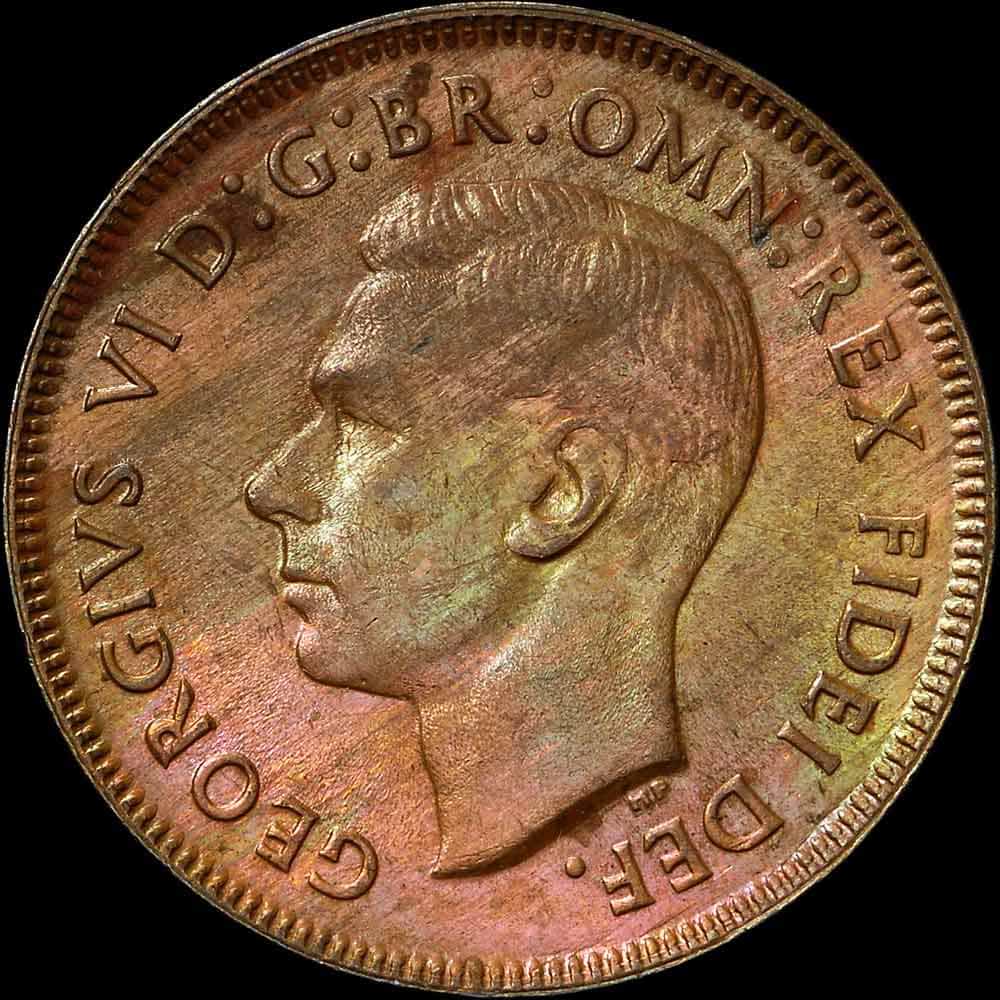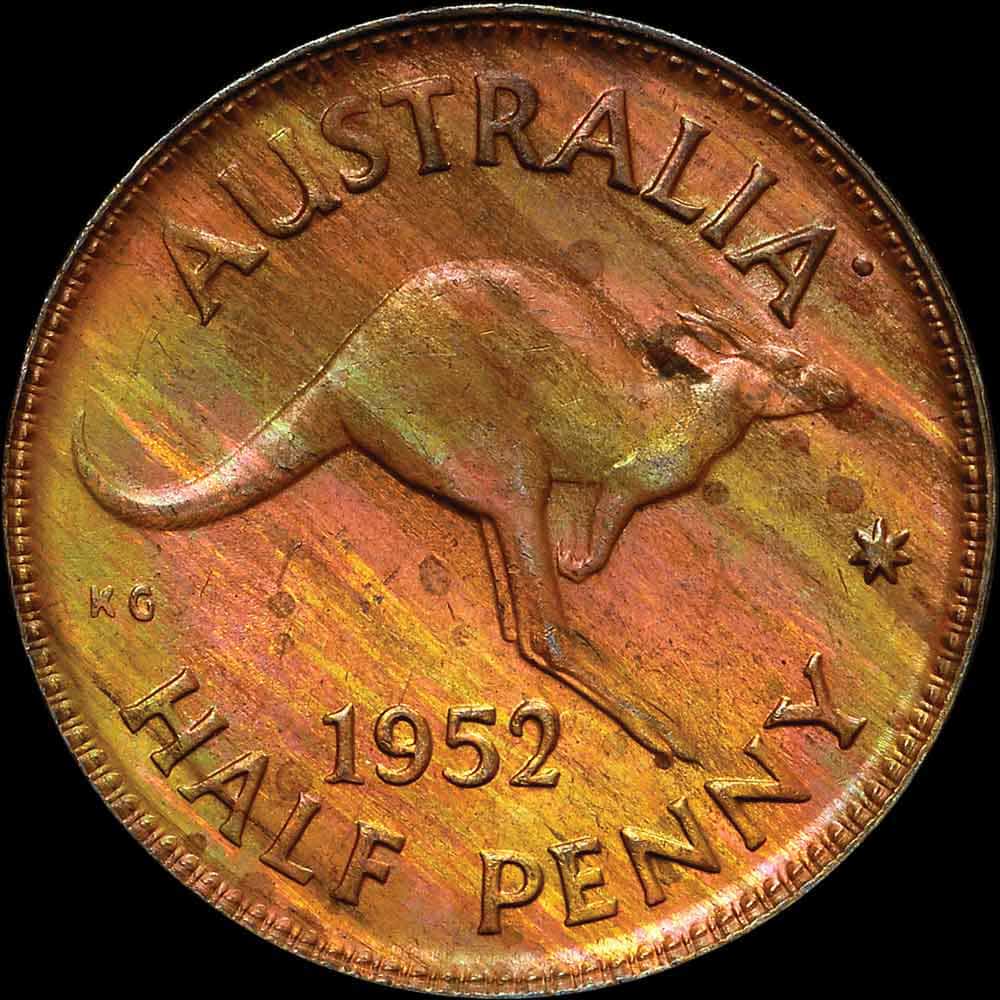Australia 1952 A. Halfpenny
| Mint: | Perth | Mintage: | 1,831,680 | Milling: | Plain |
| Weight: | 5.67 grams | Diameter: | 25.5 mm | Composition: | 97% Copper, 2.5% Zinc, 0.5% Tin |
|
Click to enlarge
Wear
Next
Prev

Obverse 5 - English (melbourne modified)
|
Click to enlarge
Wear
Next
Prev

Reverse B - London
|
||||||||||||||||||||||||||||||||||||||||||||||||||||||||||||||||||||||||
|
|
||||||||||||||||||||||||||||||||||||||||||||||||||||||||||||||||||||||||
| Click on Wear to show high points first susceptible to wear | |||||||||||||||||||||||||||||||||||||||||||||||||||||||||||||||||||||||||
Value
|
BM
Ad
NP
|
8
Good
VG10
|
10
VG
F12
|
12
about F
F15
|
15
Fine
VF20
|
20
good F
VF25
|
25
about VF
VF30
|
30
Very Fine
VF35
|
35
good VF
EF40
|
40
about EF
EF45
|
45
Ext Fine
AU50
|
50
good EF
AU53
|
53
about Unc
AU55
|
58+
virt Unc
AU58
|
58-60
Uncirc
MS60
|
58-61
Uncirc
MS61
|
58-62
Uncirc
MS62
|
63-64
Choice Unc
MS63
|
64-65
near Gem
MS64
|
65-66
Gem
MS65
|
66-67
Gem
MS66
|
67-68
Gem
MS67
|
68
near Flaw
MS68
|
69
virt Flaw
MS69
|
70
Flawless
MS70
|
Proof
|
|---|---|---|---|---|---|---|---|---|---|---|---|---|---|---|---|---|---|---|---|---|---|---|---|---|---|
| B |
BV
+
NGC
PCGS
|
BV
+
NGC
PCGS
|
BV
+
NGC
PCGS
|
BV
+
NGC
PCGS
|
BV
+
NGC
PCGS
|
BV
+
NGC
PCGS
|
BV
+
NGC
PCGS
|
BV
+
NGC
PCGS
|
$2
+
NGC
PCGS
|
$3
+
NGC
1
PCGS
1
|
$5
+
NGC
PCGS
|
$10
+
NGC
PCGS
4
|
$15
+
NGC
PCGS
5
|
$30
+
NGC
PCGS
|
$40
+
NGC
PCGS
1
|
$50
+
NGC
PCGS
6
|
$75
+
NGC
1
PCGS
20
|
$125
+
NGC
PCGS
13
|
$250
+
NGC
PCGS
|
$400
+
NGC
PCGS
|
$750
+
NGC
PCGS
|
$1500
+
NGC
PCGS
|
-
+
NGC
PCGS
|
-
+
NGC
PCGS
|
Y
|
| RB |
"
+
NGC
PCGS
|
"
+
NGC
PCGS
|
"
+
NGC
PCGS
|
"
+
NGC
PCGS
|
"
+
NGC
PCGS
|
"
+
NGC
PCGS
|
"
+
NGC
PCGS
|
"
+
NGC
PCGS
|
$5
+
NGC
PCGS
|
$8
+
NGC
PCGS
|
$10
+
NGC
PCGS
|
$20
+
NGC
PCGS
|
$40
+
NGC
PCGS
|
$50
+
NGC
PCGS
|
$60
+
NGC
PCGS
|
$100
+
NGC
PCGS
4
|
$150
+
NGC
1
PCGS
21
|
$300
+
NGC
1
PCGS
14
|
$500
+
NGC
PCGS
|
$1000
+
NGC
PCGS
|
$1750
+
NGC
PCGS
|
-
+
NGC
PCGS
|
-
+
NGC
PCGS
|
-
+
NGC
PCGS
|
Y
|
| R |
"
+
NGC
PCGS
|
"
+
NGC
PCGS
|
"
+
NGC
PCGS
|
"
+
NGC
PCGS
|
"
+
NGC
PCGS
|
"
+
NGC
PCGS
|
"
+
NGC
PCGS
|
"
+
NGC
PCGS
|
"
+
NGC
PCGS
|
"
+
NGC
PCGS
|
"
+
NGC
PCGS
|
"
+
NGC
PCGS
|
$50
+
NGC
PCGS
|
$60
+
NGC
PCGS
|
$100
+
NGC
PCGS
|
$150
+
NGC
PCGS
|
$300
+
NGC
PCGS
|
$500
+
NGC
PCGS
|
$1000
+
NGC
PCGS
|
$1750
+
NGC
PCGS
|
-
+
NGC
PCGS
|
-
+
NGC
PCGS
|
-
+
NGC
PCGS
|
-
+
NGC
PCGS
|
Y
|
BM
Benchmark
Ad
Adjectival
NP
NGC/PCGS
Collectable grades
Does not exist by definition
Investment grades
-
Unlikely to exist
Aspirational grades
BV
Bullion or metal value
Not known in these grades
''
Value as above
Proof
Y (Yes)
N (Not known)
N (Not known)
Last updated April 2024
Notes:
By late 1952, the Perth Mint had acquired the ability to produce its own working dies from a master die. It is tempting to assume that the new 'A•' mint mark, which was used for the first time to distinguish the Perth production, signaled this achievement but it is far more likely that the reverse die that was used was supplied by the Melbourne Mint. Both the Perth and Melbourne Mints were known to be experimenting with low relief reverses to match the shallow portrait of the new queen which was to appear on the 1953 Halfpenny, but it is unlikely that Perth would have been confident enough at this stage to use its own version. The 'A•' mint mark was only used for two years and may coincide with the experimental shallow reverse used on a small stop-gap run of 1952 halfpennies bearing the portrait of George VII and the larger production of Queen Elizabeth halfpennies that followed in 1953. However, it is difficult to establish if the shallow reverse dies were ever used in production, and because of this we have chosen not to acknowledge a change to the reverse type.
